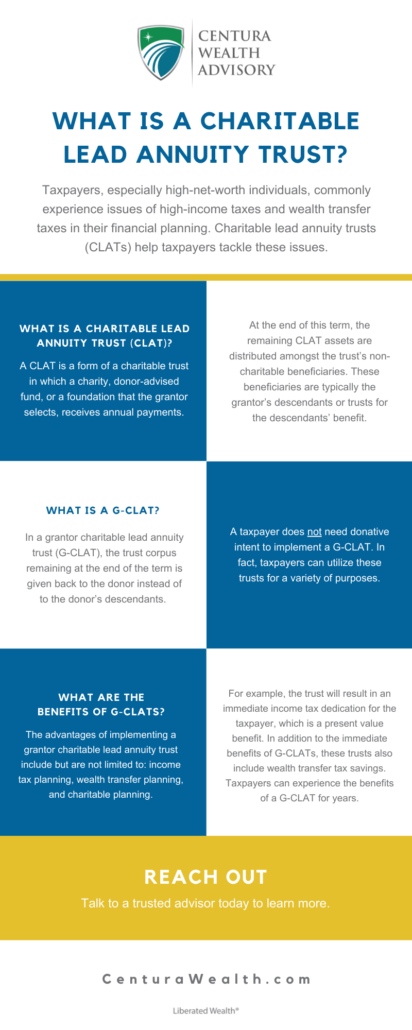What is a Charitable Lead Annuity Trust (CLAT)?
Taxpayers, especially high-net-worth individuals, commonly experience the issues of high-income taxes and wealth transfer taxes in their financial planning.
Charitable lead annuity trusts, or CLATs, help taxpayers tackle these issues through advantages including tax deductions and wealth transfer planning.
Below, we’ll discuss:
- How charitable lead annuity trusts (CLATs) work, and
- How taxpayers can implement a grantor charitable lead annuity trust (G-CLAT) to experience both long and short-term tax benefits
What is a Charitable Lead Annuity Trust?
A charitable lead annuity trust (CLAT) is a charitable trust in which a charity, donor-advised fund, or a foundation that the grantor selects, receives annual payments. These payments may be set for a term of years or for the grantor’s lifetime.
At the end of this period, the remaining CLAT assets are distributed amongst the trust’s non-charitable beneficiaries. These beneficiaries are typically the grantor’s descendants or trusts for the descendants’ benefit.
What is a Grantor Charitable Lead Annuity Trust?
In a grantor charitable lead annuity trust (G-CLAT), the trust corpus remaining at the end of the term is given back to the donor instead of the donor’s descendants.
Does a Taxpayer Need Donative Intent to Implement a G-CLAT?
A taxpayer does not need donative intent to implement a G-CLAT.
In fact, taxpayers can utilize these trusts for a variety of purposes. Let’s review how G-CLATs work and their advantages.
How Does a G-CLAT Work?
Let’s take a look at G-CLAT mechanics. We like to break it down like this:
1. Grantors fund CLAT with a one-time deposit
2. The taxpayer implements a pre-determined annual charitable payment schedule
3. Grantor(s) receive income tax dedication to be used up to six years – likely at 99% or more of the deposit
4. All taxable events flow back to the grantor(s)
5. Invest in Limited Partners real estate
6. If structured properly, the remainder interest transfers to the remainder beneficiary, free of estate tax
What Are the Benefits of G-CLATs?
The advantages of implementing a grantor charitable lead annuity trust include, but are not limited to:
- Income tax planning
- Wealth transfer planning
- Charitable planning
Let’s speak about each of these in a bit more detail.
Income Tax Planning
Taxpayers will experience the benefits of both immediate and long-term tax benefits once they’ve successfully implemented a G-CLAT. The trust, for example, will result in an immediate income tax dedication for the taxpayer, which is a present value benefit.
This immediate income tax reduction is:
- Subject to 20 to 30% of adjusted gross income (AGI) limitation
- Able to be utilized over six tax years
- Ideally consumed at the highest marginal income tax rates
Wealth Transfer Planning
In addition to the immediate benefits of G-CLATs, these trusts also include wealth transfer tax savings. Through these savings, the taxpayer can experience the benefits of a G-CLAT for years.
Charitable Planning
While the taxpayer does not need to have donative intent, charitable planning benefits G-CLATs if the taxpayer decides to participate.
For instance, as a future benefit, G-CLATs provide satisfying charitable annuity payments with appreciated assets, avoiding recognition of gain on these distributions to 501(c)3s.
How to Get Started
At Centura Wealth Advisory, we know the minute details of how to optimize a grantor charitable lead annuity trust or a charitable lead annuity trust. In fact, our team has successfully implemented over 280 CLAT transactions.
Read on to learn more about our 5-Step Liberated Wealth Process and how Centura can help you liberate your wealth.

Disclosures
Centura Wealth does not make any representations as to the accuracy, timeliness, suitability, or completeness of any information prepared by any unaffiliated third party, whether linked to or incorporated herein. All such information is provided solely for convenience purposes and all users thereof should be guided accordingly.
We are neither your attorneys nor your accountants and no portion of this material should be interpreted by you as legal, accounting, or tax advice. We recommend that you seek the advice of a qualified attorney and accountant.
For additional information about Centura, please request our disclosure brochure as set forth on Form ADV using the contact information set forth herein, or refer to the Investment Adviser Public Disclosure website (www.adviserinfo.sec.gov). Please read the disclosure statement carefully before you engage our firm for advisory services.



